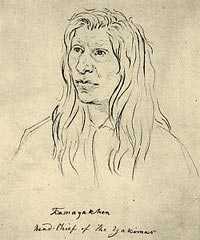Chief Kamiakin
| Kamiakin | |
|---|---|
 Drawing by Gustav Sohon (1855). Credit: Washington State Historical Society | |
| Born |
Kamiakin: "He won't go" 1800 near Starbuck, Washington |
| Died |
1877 Rock Lake (Washington), Washington |
| Occupation | Chief |
| Known for | Leading resistance against encroaching settlers |
Chief Kamiakin (1800–1877) was a leader of the Yakama, Palouse, and Klickitat.
Early life
Kamiakin was of mixed Nez Perce, Spokane and Yakama ancestry. His father Ki-yi-yah was the son of a Nez Perce father and a Spokane mother. His mother was Yakama. In 1825 Kamiakin married Sal-kow, also a Yakama. Sal-kow's grandfather was the Yakama leader Weowikt and her father Te-i-as was also a Yakama leader.[1]
Yakima War
The new Washington Territory governor, Isaac Stevens, spearheaded an ill-fated treaty process by threatening to remove the natives by force if they didn't sell their lands. Kamiakin began to organize immediately, allying himself with the chiefs Peo-peo-mox-mox (Yellow Bird) of the Walla Walla, and Allalimya Takanin (Looking Glass) of the Nez Perce. He eventually formed an alliance with a total of 14 tribes living on the Columbia plateau. The alliance was formed in order to resist American settlers and government officials in the Washington Territory. The hostilities are referred to as The Yakima Indian War of 1855.
Kamiakin convened a council with representatives from all of the tribes in the Grande Ronde Valley in Eastern Oregon in 1855 in order to discuss how best to deal with the invaders and keep their lands. Governor Stevens was tipped off about the meeting when Lawyer, a Nez Perce, informed him of the decisions made by the tribal representatives. At the subsequent Walla Walla Council, when Kamiakin arrived, he noticed the large number of Nez Perce and U.S. Government officials and realized his confidences had been betrayed. Stephens had used the information about the earlier meeting to marshal support for establishing reservations amongst the wavering tribal factions. When Oregon's Superintendent of Indian Affairs asked Kamiakin to speak, the proud Yakama refused. The other chiefs eventually pressured Kamiakin into signing the treaty "as an act of peace" that established the Yakima reservation.[2][3]
Kamiakin led a band of warriors into the first engagement of the War when on October 4 and 5, 1855, he defeated a force of 84 soldiers led by Major Haller near Simcoe Valley. Kamiakin was also instrumental in the final battle of the War. On September 5, 1858, Colonel George Wright, with a force of 700 soldiers, defeated Kamiakin and his warriors at the Battle of Four Lakes.[4] Kamiakin was wounded in the battle when he was struck by a pine tree felled by cannon fire. Colestah is reported to have saved her husband from capture by the U.S. soldiers. In the end, Kamiakin was the only chief who refused to surrender, escaping to Kootenai, British Columbia, then to Montana where he lived with the Flathead tribe.[2]
Final years
In 1860, he returned to his home on the Palouse River. Following the death of Colestah in 1864, he then moved to his father's homeland near Rock Lake (Washington) in Washington. Ranchers led by William Henderson repeatedly tried to drive Kamiakin from his ancestral lands, but superintendent of Indian Affairs, Robert Milroy, intervened and vowed (successfully) to allow Kamiakin to live out his days there. On at least two occasions Kamiakin was offered food and clothing by local Indian agents, charity which he steadfastly refused.[2]
The day before he died (sometime in 1877) he was baptized a Catholic and given the name "Matthew."[5] The year following his death, according to his people's customs, Kamiakin's grave was opened by his son (Tesh Palouse Ka-mi-akin) and his body was wrapped in a new blanket. Several years later, when he was exhumed in order to be reburied elsewhere, it was discovered that "the head and shoulders had been cut off and removed" [6] probably for "public exhibition as a curiousity." [7] Historian Clifford Trafzer states that friends of Kamiakin were able to retrieve these relics.[2] In any case, what was left of his remains were finally interred at Nespelem, Washington, a village he had originally founded.
Schools named after Kamiakin
There are at least four schools named for Chief Kamiakin:
- Chief Kamiakin Elementary School in Sunnyside, Washington
- Kamiakin High School in Kennewick, Washington
- Kamiakin Junior High in Kirkland, Washington
- Kamiak High School in Mukilteo, Washington
See also
- Colestah, wife of Chief Kamiakin
- Qualchan, nephew of Chief Kamiakin
- Kamiak Butte, which is named after Kamiakin
- Kamiakin's Gardens, listed on the National Register of Historic Places
Notes
References
- -- Historylink.org essay 5288 First irrigation ditch in the Yakima Valley is dug at the Saint Joseph Mission in 1852.
- Kamiakin, Head Chief of the Yakamas C. 1800-1878 from The Treaty Trail: US-Indian Treaty Councils in the Northwest(retrieved Tuesday, May 6, 2008)
- Dockstader, Frederick J. "Kamaiakin" IN Great North American Indians: Profiles in Life and Leadership. New York : Van Nostrand Reinhold Co., 1977 (OCLC 3167970)
- Mooney, James. "Kamaiakan" IN Handbook of American Indians north of Mexico Washington : G.P.O., 1907–1910, vol. 1 (OCLC 26478613)
- Ruby, Robert H. "Kamiakin" IN American national biography New York : Oxford University Press, 1999, vol. 12 (OCLC 39182280)
- Splawn, A.J. Ka-mi-akin, last hero of the Yakimas, Portland, Or. : Kilham Stationery & Printing Co., 1917 (OCLC 1086645)
- Trafzer, Clifford. "Kamiakin" IN Encyclopedia of North American Indians, New York : Houghton Mifflin Co., 1996 (OCLC 34669430)
External links
- Chief Kamiakin (ca. 1800-1877) at HistoryLink
- Kamiakin: Head Chief of the Yakamas
- Kamiakin and the Yakima Indian War of 1855
- Biography of Charles Pandosy and his interactions with Chief Kamiakin
- Gold in the Northwest -- A Snapshot History
- St. Joseph Mission at the Ahtanum Was Crucial to the History of Catholicism in Central Washington